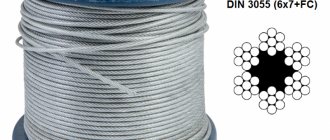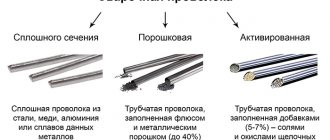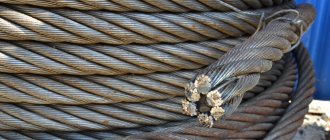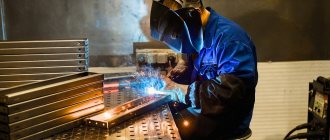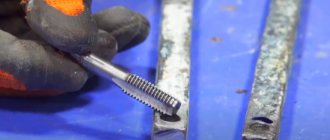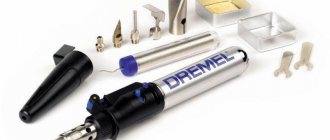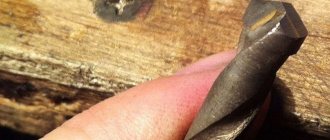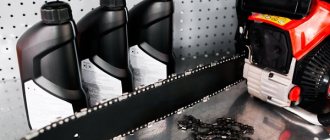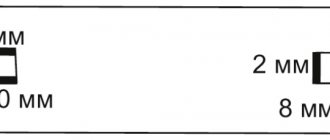Steel rope is one of the most common types of wire products, which are made by various laying methods. Moreover, it is the main element of lifting structures and mechanisms, which carries the entire load-bearing load. Such structures are used in various industries, for example, in mining, coal, oil, mechanical engineering, agricultural and others. And in this regard, there are many types of products made from steel strands and wires. The types will be discussed in more detail in the classification.
The main type of ropes and cables made of steel
There are many classifications of steel ropes depending on the classifying feature. If we take structure as such a feature, then steel ropes can be divided into single, double and triple .
- Single ropes are ropes twisted from one or several layers in a spiral. Or else they are called spiral ropes, the name of which comes from the laying method. Single ropes are intended for laying cables. The cables are made from single strands of round cross-section.
- Double - made by concentrically laying strands in 1 or several layers. They are designed to make stronger ropes, also called strands.
- Triple lay ropes are made from strands using the method of single-layer concentric lay in a spiral.
In addition to structure, there are other main classifying features. For example, cross-sectional shape, weaving type, core material, laying method and direction, mechanical properties, manufacturing accuracy and purpose. Steel cables can have either a flat or a round cross-section. The steel strands from which the cables are woven are also divided according to the cross-sectional shape into round and shaped strands, and the latter, in turn, are flat-stranded and three-stranded.
Based on the type of weaving , ropes are classified as:
- products made of wires in which the layers are touched using a point method, this type of weaving is called point touching (TC);
- products consisting of layers of wires touching each other in a linear manner; this type of weaving is called linear touching and is designated as LC;
- in such products wires of the same diameter are used, they are conventionally designated as LK-O;
- a type of weaving in which the wires in the last layer have different diameters, symbol LK-R, indicating a linear tangency;
- LK-Z, a type of weaving in which the wires touch linearly and with each other and with the filling wires;
- LK-RO - as can be seen from the abbreviations, such wires include strands braided linearly, having different diameters.
- TLCs are a combination of the first two types. That is, the wires come into contact using the linear-point method.
Based on the material of the core, they are distinguished - with an organic core, that is, in the center of the strands it is made of synthetic or natural fibers such as manila, hemp, cotton, nylon, lavsan, viscose, etc.
According to the weaving method , there are unwinding and non-unwinding ones, which differ from each other in that the latter retain the original position of the strands after use. Weaving can be either to the right or to the left. To determine the direction you need to look at the last layer, depending on the structure it can consist of wires or strands, for example, in a single lay the outer layer consists of wires, and in a double lay it consists of strands, and in a triple lay it consists of strands.
According to their mechanical properties, ropes are divided into three types based on the quality of the product, respectively, normal, high, and increased quality. All three types have their own symbols: mark1, mark VK and mark V.
There is a classification based on one more important feature - manufacturing accuracy . In terms of accuracy, ropes come in normal accuracy and, accordingly, increased accuracy, which is designated as T. Increased accuracy differs from normal accuracy in the presence of a maximum deviation in the diameter of the rope.
Design
Metal ropes may have a different design from each other, but the basis for all products is the same. The core of the rope is based on a core, and the wire is woven around it. The core is made not only of steel, but also of non-metallic materials. A steel core is necessary to model the future rope and to protect its surface from sagging. Most often it is protected with an anti-corrosion coating made of zinc, less often polymers are used for these purposes.
If a core made of organic materials is used, it could be, for example, hemp or sisal, then it is impregnated with a special lubricant. This avoids its premature rotting and reduces friction between its components. Cores made of polyamide threads are often used. An important advantage of all ropes with inorganic cores is their low weight and high flexibility.
- In general, according to the level of flexibility, the following types of steel ropes are distinguished:
- With a low degree. This level corresponds to a product with 42 wires and a hemp core.
- With an average degree. This type corresponds to a rope with 72 wires twisted into strands.
- With a high degree. This level includes a cable with a hemp core and steel wire in the amount of 144 pieces, twisted into 6 strands.
Before choosing a cable, it is necessary to take into account a number of its properties. The main characteristic of steel ropes, which we have already mentioned, is flexibility. It largely determines in what area the rope will be used. It is also necessary to take into account strength, maximum tension, and load capacity. The tensile strength depends on the safety factor and the diameter of the cable. Often an important parameter is resistance to aggressive environments; with increased requirements, the product undergoes additional processing. Sometimes it is important to consider the weight of the rope.
Purpose of steel ropes
As mentioned above, steel cables are the main load-bearing elements of any lifting mechanism. For example, a crane, drilling rig, excavators, freight and passenger elevators and others. In addition, steel cables are used as a material for the manufacture of load-handling and other durable devices that can withstand enormous mechanical loads. Therefore, it is important to approach the selection of such products with great responsibility. Today, the market offers a wide range of cables and ropes made of steel, and in connection with this, the buyer is faced with the problem of choice.
In order not to make a mistake with your choice, you need to understand all the features and nuances, which can take years to study. Therefore, experts recommend turning to professionals when purchasing steel products. But nevertheless, there are criteria that professionals adhere to, and the average buyer should adhere to them.
Lay in steel cables
The lay in metal cables determines how the wires in the strands form the structure of the rope. In simple words, the wire strands have a twisting algorithm that provides a tightly formed structure. The term “lay” is used to describe the direction of the twisted wire in relation to the strands in the finished cable. With correct laying, the strands are wound around the rope core clockwise, with left-handed or right-handed - counterclockwise.
Conventional lay means that the wire in the strand is laid in the opposite direction to the direction in which the strands are laid in the final rope. The direction of lay of a cable rope does not affect the breaking force of the cable. However, the combination of strand lay and rope lay greatly influences the performance of the cable. For example, if we are talking about a rope structure where rotation is prevented when right-handed and left-handed strands are involved.
Cable selection criteria
The criteria may depend on the characteristic that is taken as a basis. However, there are generally accepted rules for choosing according to quality and purpose ; these rules are called GOST. GOST presents a more accurate and detailed classification of all known types of steel cables and products. In accordance with this classification, there are main parameters that you should pay attention to when purchasing:
- purpose, ropes and cables are different and intended for different purposes, so it is important to clarify this parameter;
- type of construction, which is determined by the number of strands in the rope;
- laying method and direction;
- strength;
- core material;
- characteristics and properties of wire and others.
GOST steel ropes are manufactured in accordance with the requirements of technological regulations approved by government agencies. Therefore, the presence of a mark of compliance with GOST indicates the quality of the product. Since each type of product listed in the classification must be made from certain materials and using a special technology that is approved in GOST.
For example, a steel cable GOST 5269 , the core material for such a cable must comply with the list given in GOST, that is, hemp, sisal and polypropylene can be used as the material, jute, chemical and cotton fibers must comply with regulatory documentation.
Just as in the case of the purpose of each type, the GOST spells out everything down to the smallest detail about which rope is used where. Knowledge of GOST allows you to choose a high-quality and reliable product, and this knowledge should not be neglected.
Types of cores in steel cables
Cables come with three types of cores:
- A wire core that has the same construction as the outer cores.
- Fiber core is more often used for rigging. Such cables have high tensile strength, and due to the increased wire diameter, they are more resistant to abrasion. For the manufacture of such cables, sisal (coarse fiber) or polypropylene is most often used. This makes it possible to provide a flexible base for the strands in the rope structure. Fiber cores are used to make ropes where elasticity is required. Fiber cores are not suitable for outdoor use.
- Independent steel cable core. This type is suitable for the manufacture of cables that are used in tension, subject to severe compressive loads, and high operating temperatures. This type of rope is heavier and stronger than fiber-core rope.
Deformation and wear of ropes
Most often, wire connections fail due to tension, corrosion or mechanical stress. When ruptures are detected under loads, it is important to check the level of safety, especially if the rope is used for heavy loads.
Corrosion damage occurs as a result of operation in wet, salty, acidic conditions or exposure to other chemical elements. In this case, you need to make every effort to fix the problem. Alternatively, you can use a special lubricant.
Mechanical damage consists of cuts or punctures. This occurs due to careless handling, impact. Mechanical rupture also occurs due to sudden release of heavy weight.
Deterioration of the strength of cable strands often occurs as a result of bending wear. The reasons for abrasion of strands may be:
- bending and twisting of ropes due to load;
- contact stresses between individual strands;
- wind fluctuations and other dynamic effects. The source of the oscillation is called a "reclaimer".
When choosing a cable for specific purposes, it is important to pay attention to the quality of the material and its properties. If you intend to use the rope in harsh environmental conditions, be sure to lubricate the product. Steel cables are a complex engineering object, the selection of which must be approached wisely.
Application area
One of the most notable types of steel cables produced by modern industry is a product made of galvanized wire. For additional protection against corrosion, this steel cable is encased in a PVC sheath. Thanks to these features of its design, the cable can be successfully operated even in the most unfavorable conditions. Thus, products of a similar design are used for tying loads lowered into liquid media; they are used to install antennas and masts, power transmission and communication lines.
Modern manufacturers have also mastered the production of metal-polymer cables, the wire of which can be additionally galvanized, which gives the product even greater corrosion resistance. There is a simpler way to protect the cable from the occurrence and development of corrosion processes, which is also used by modern manufacturers. To do this, a flexible steel cable is coated with a layer of special lubricants or an additional layer formed from galvanized wire is introduced into its structure.
On the modern market you can also purchase cables whose surface is protected by a material that can successfully withstand combustion, high temperatures and temperature changes.
Types and labeling of products
When choosing a steel cable to solve certain problems, you should take into account a lot of factors: its structure, length and diameter, as well as the main parameters - flexibility and the maximum load that it can withstand. It is imperative to pay attention to the design of such a product, which largely determines its main characteristics. Cables are classified as one or another type of construction depending on the number of twists they are made of. Thus, a single lay steel cable consists of a core onto which wire is wound in a spiral. Such elements are often used as individual strands for the manufacture of more complex products - double lay steel cables.
The design of such products includes a core onto which the strands are wound in accordance with a certain sequence. The strands are used to make both single-layer and multi-layer cables, which can withstand significant loads and may have the ability not to twist during operation, which is very important in many situations. The most complex in their design are triple lay cables, for the manufacture of which so-called strands are used. Strand is, in fact, a double lay steel cable, specially made in order to later form more complex products from it.
To produce cables of complex designs, strands made in various ways can be used. To mark and determine the type of strands from which the cable is made, the designation LK is used - linear tangent. The strands with the simplest structure (LK-0) are characterized by the same lay pitch in all layers and its repeating pattern.
To form layers of strands, wire of different diameters can be used, in such cases it is designated LK-R. There are also mixed types of strands, some layers of which are made from wire of the same diameter, and others from wire of different diameters. Such strands are designated LK-RO. The method of manufacturing strands is very important to consider when choosing cables for various purposes, since it is this method that largely determines the properties that the finished product has.
For the production of steel cables, strands are also used that are made according to the principle of not linear (LK), but of point contact of the wire in them (TC). The design features of such strands are that each layer uses a different wire winding pitch, and in addition, these layers intersect each other. It should be said right away that it is not recommended to use steel cables with such strands in cases where they will experience significant dynamic loads.
Types of weaving steel cables
This is explained by the fact that due to the low density of the internal structure of such products, their layers are subject to strong friction under dynamic loads, which can lead to rapid failure of the entire cable. There are also combined cables, for the manufacture of which strands of the LK and TK types are used. They are designated accordingly TLC. Each of the above types of steel cables should be selected depending on their purpose, carefully assessing the conditions in which they will be used.
